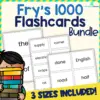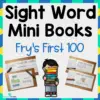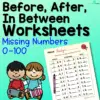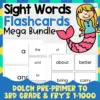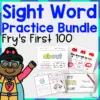Children love to learn about animals. Animals that are found in the zoo are one of the categories that children are familiar with. These wild animals are easily remembered because of their unique features.
Let children explore these creatures through these ten crafts that will provide enjoyment and learning to the young learners.
Great Zoo Crafts for Preschoolers
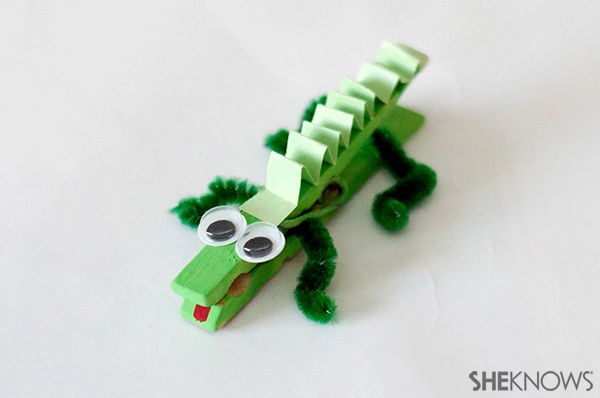
Turn a wooden clothespin into a ferocious green beast with this craft. Children will have a fun time making this. It can be used as counters in the math center. Add a magnet to the back to turn it into a refrigerator magnet.
Folding the paper, painting, and assembling the craft will help children improve their fine motor skills. Use this craft to teach children a science lesson on different reptiles.
It is also perfect for the book “There’s an Alligator Under My Bed” by Mercer Mayer. Make several of these and hide them so the children can play a hunting game.
To make the alligator, paint the clothespin green and let the paint dry. Cut off two short pipe cleaners for the feet. Bend these for a V and glue them on the clothespin. Bend the ends of the pipe cleaners to make the feet.
Make the textured back by cutting a piece of green construction paper the size of the clothespin. Fold it accordion style and glue it on the clothespin. Attach the googly eyes. Finally, paint the inside part of the clothespin red for the alligator’s tongue.
For this activity, you will need:
- Wooden clothespin
- Paint
- Paintbrush
- Pipe cleaner
- Scissors
- Construction paper
- Googly eyes
- Glue
For more information on this activity, go to SheKnows.com. We also have more alligator crafts you might want to check out!
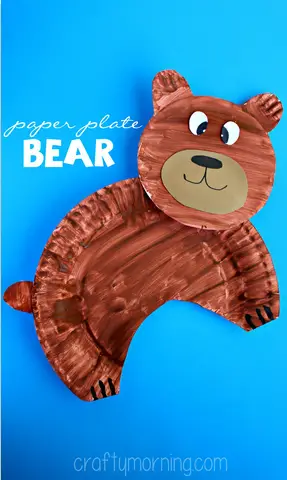
This paper plate bear is a wonderful bear craft for young children to make. It can be used to teach more about the animal, its characteristics, food, and habitat through a science lesson.
Painting, cutting, and assembling it will help improve children’s fine motor skills. It is a perfect craft for puppet play or to retell stories, such as “Brown Bear, Brown Bear What Do You See” by Bill Martin Jr.
As children retell stories with this craft, it will enhance their oral language skills, comprehension, and memory.
Start making the bear’s body by cutting a small letter C on the paper plate to make the bear’s legs. Cut out the bear’s head from the second paper plate. Cut out a circle with the ears. Refer to the pictures on the site for these steps.
Next, paint both plates brown. While the paint dries, cut out an oval from the tan paper and draw the mouth using a marker. This will be the bear’s muzzle. Cut out two small ovals for the bear’s eyes and add the pupils.
Attach these to the bear’s head. Glue the head on the body to complete the craft.
For this activity, you will need:
- Paper plate
- Paint
- White and tan paper
- Marker
- Glue
- Scissors
For more information on this activity, go to CraftyMorning.com.
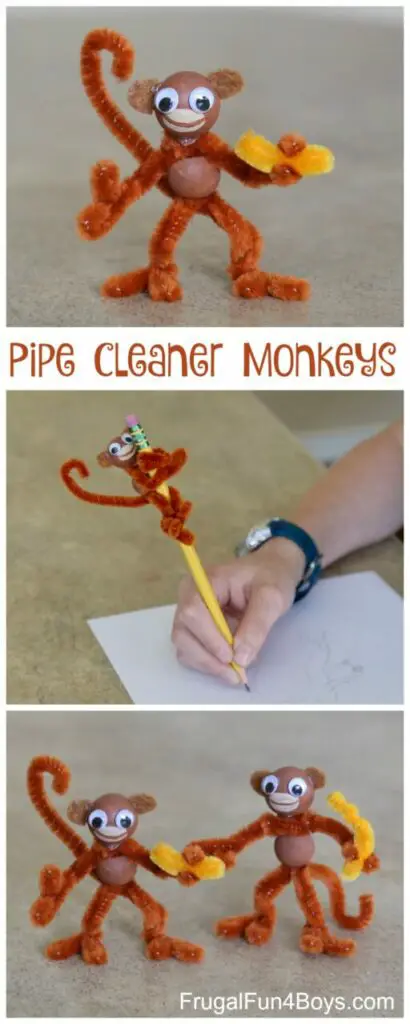
These adorable monkeys can be used as manipulatives to go with the rhyme “Five Little Monkeys.” This nursery rhyme comes in two versions, the first one where they jump on the bed and the second where they sit on a tree.
These pipe cleaner monkeys can be used in both rhymes to help children improve their oral language skills and memory. As each monkey exits in the rhyme, this can be an excellent opportunity to discuss basic subtraction concepts with children.
Start by painting the beads brown. Once dry, paint the mouth tan and brown. Take three brown pipe cleaners and twist one in the middle. Insert one of the wooden beads. Bend and twist to make the legs and arms.
Refer to the pictures on FrugalFun4Boys.com for the step-by-step process.
Cut out two round shapes from the brown felt to make the ears. Use a hot glue gun to attach the googly eyes and ears to the monkey’s head. Glue the wooden head on the body.
Finally, cut a small yellow pipe cleaner and attach it to the hand for the banana.
For this activity, you will need:
- Brown and yellow pipe cleaners
- Wooden beads
- Googly eyes
- Hot glue gun
- Brown felt
- Paint
For extended crafting, browse our list of adorable monkey crafts!
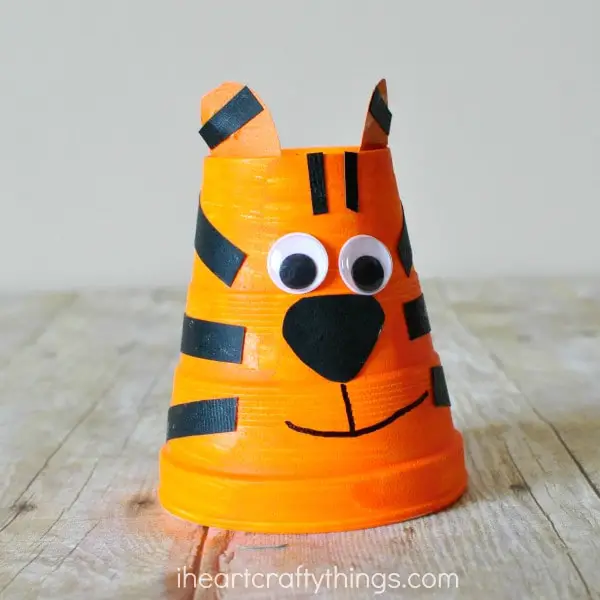
With its eye-catching color and unique stripes, this tiger is perfect as decor for a zoo-themed classroom. Use this to teach position words and phrases. Place a small object like a marble in front of the tiger.
Ask children where the marble is and repeat with other positions. Vary the number of stripes on the tiger for children to practice their counting skills. You can also use it as a puppet in pretend play area to help children develop their oral language skills.
This tiger craft is perfect for the book “Stripes the Tiger” by Jean Leroy. It is a hilarious story about a cat that behaves like a tiger until it meets one. Discuss the similarities and differences between these two felines with a science lesson.
Start by painting the cup orange. Once the paint dries, take a piece of black paper and cut out the nose and stripes.
Cut out ears from the orange cardstock. Glue these on the cup. Attach the googly eyes and use the black marker to add the mouth.
For this activity, you will need:
- Foam cup
- Paint
- Paintbrush
- Cardstock
- Googly eyes
- Scissors
- Glue
For more information on this activity, go to IHeartCraftyThings.com.
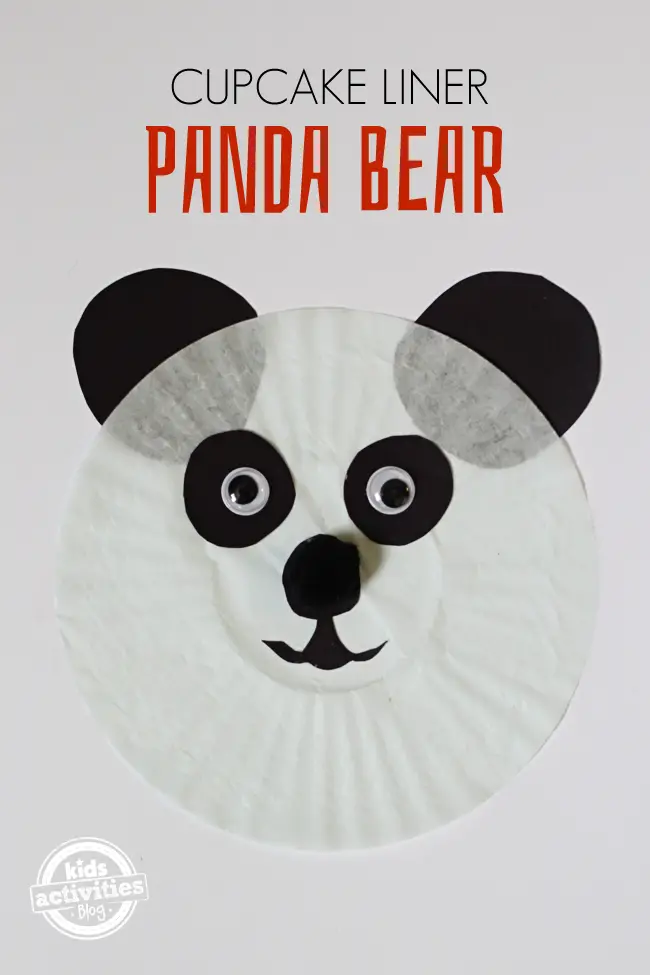
Children will find this craft simple and easy to make. Use this panda craft to teach the circle shape. Ask children to count the number of circles in the craft. Children will improve their fine motor skills as they complete this craft.
Inform children that the panda’s black and white coloring is not unique. With a science lesson, show children that there are many animals with the same coloring. Explain the concept of camouflage with these colors.
Discuss the animal’s food, habitat, and behavior. Talk about the dangers that these animals face and the conversation efforts to save them from extinction.
To make the panda, flatten the white cupcake liner. Cut out the eyes, ears, and mouth from the black construction paper. Glue the ears to the back of the cupcake liner. Attach the googly eyes on the black circles for the eyes. Glue these on the liner.
Glue the mouth and the black pompom to complete the panda.
For this activity, you will need:
- Cupcake liner
- Googly eyes
- Pompom
- Construction paper
- Glue
- Scissors
For more information on this activity, go to KidsActivitiesBlog.com.
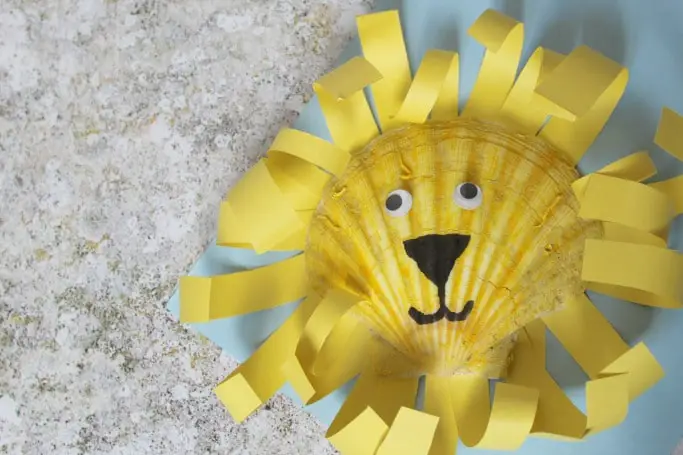
Collecting shells is a wonderful hobby to teach children. This provides a great sensory experience for children. These shells can be turned into something awesome like this yellow lion craft. With a science lesson, explain how a lion differs from other big cats like tigers.
Let children explore the texture of the shell. Let them touch and look closely at it. Use simple descriptive words to describe the shell. This will help increase children’s vocabulary and improve their oral language skills.
Clean and sanitize the shells before using them. The shell should be dry to ensure that the paint will stick. Use any clam-type shell for this craft. Paint it yellow and let it dry. Cut strips of yellow construction paper and curl the ends using scissors or a pen.
Attach the strips to the inside part of the shell with washi tape. Stick the paper strips around the shell to make the thick and curly mane. Next, attach the googly eyes and use the marker to add the nose and mouth.
For this activity, you will need:
- Large shell
- Washi tape
- Construction paper
- Paint
- Paintbrush
- Scissors
- Glue
- Googly eyes
- Marker
For more information on this activity, go to CraftsOnSea.co.uk.
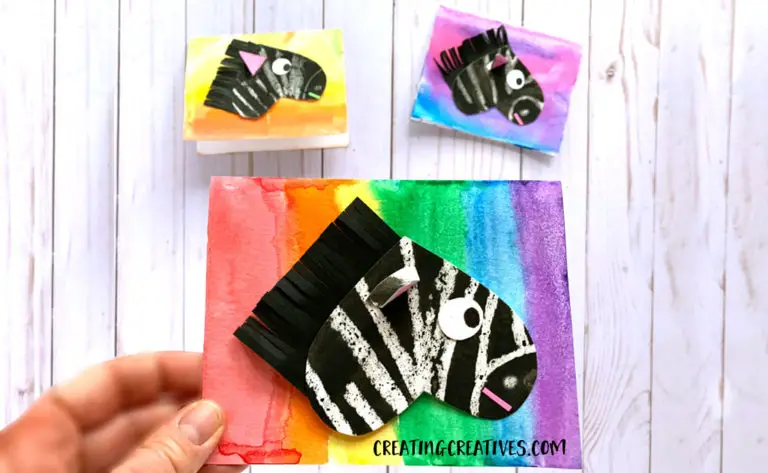
This zebra craft was made using a particular art technique called watercolor resist. Introduce this technique for children to explore its effect on paper.
Make two of these in different sizes to teach children the concept of big and small.
They can also be used to learn about mothers and babies. Explain that the mama zebra is a mare, and the baby is a foal. This will help increase children’s vocabulary.
Discuss how zebras are different and similar to horses in a science lesson.
Download and print the heart template from the site. Cut and trace it on watercolor paper. Use the scrap to make the ear and eye.
Using a white crayon, draw the stripes. The site suggests going over the children’s work to ensure that the crayon marks stick on paper. Otherwise, the paint will seep through, and the stripes will not be visible.
Apply black paint on the entire heart zebra. The waxy white stripes will show through, just be careful not to go over any area too much. While the paint dries, cut out a strip of black cardstock and snip to make fringes. This will become the zebra’s mane.
Assemble the craft by gluing the mane, ear, and eye on the heart.
For this activity, you will need:
- Printed heart template
- Watercolor paper
- Watercolors
- Paintbrush
- White crayon
- Cardstock
- Scissors
- Marker
- Pencil
- Glue
For more information on this activity, go to CreatingCreatives.com.
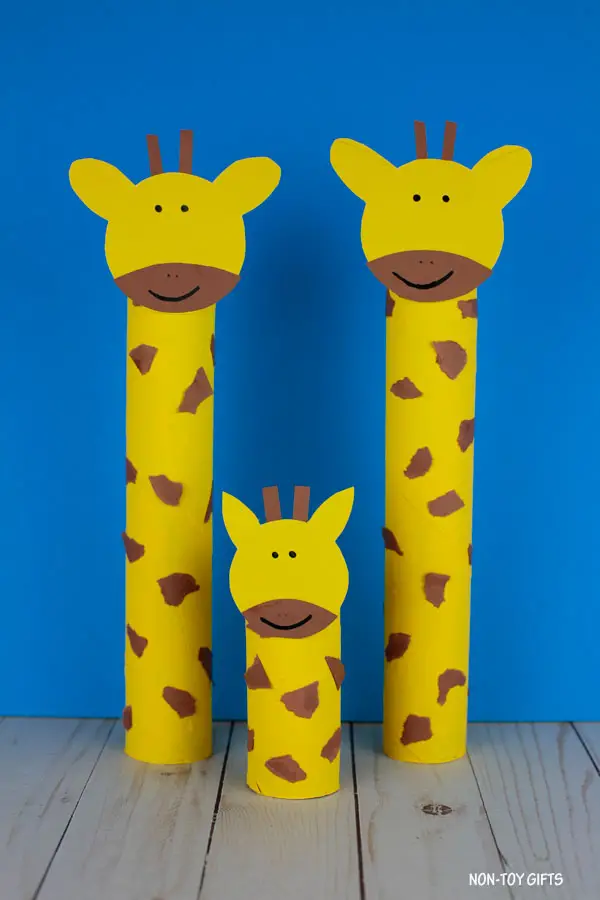
Recycle paper towels and tissue rolls to make this adorable set of giraffes that children will love. Painting, paper tearing, cutting, and pasting to make these animals will help children develop their fine motor skills.
Teach order and pattern as children arrange their heights. Use these to help children make comparisons like big and small to help develop their oral language skills. Change their facial expressions to help children understand the different emotions.
To make these giraffe crafts, paint the paper towel roll yellow. Once the paint dries, tear the brown paper into small pieces and stick them on the paper roll. These will become the giraffe’s spots.
Next, take a cup or any round object for tracing. This will make the perfect round shape for the giraffe’s head. Trace it onto the yellow construction paper and add the ears.
Take brown construction paper and cut a half circle. Trim the edge of cutting off the paper into a curved line. This will make the snout of the giraffe. Glue this on the head. Add eyes, mouth, and nostrils using a black marker.
For the horns, cut two brown strips and attach them to the head. Once the head is finished and the glue dries, stick this on the paper roll.
For this activity, you will need:
- Paper rolls
- Paint
- Paintbrush
- Marker
- Pencil
- Construction paper
- Scissors
- Glue
- Round object for tracing
For more information on this activity, go to NonToyGifts.com.
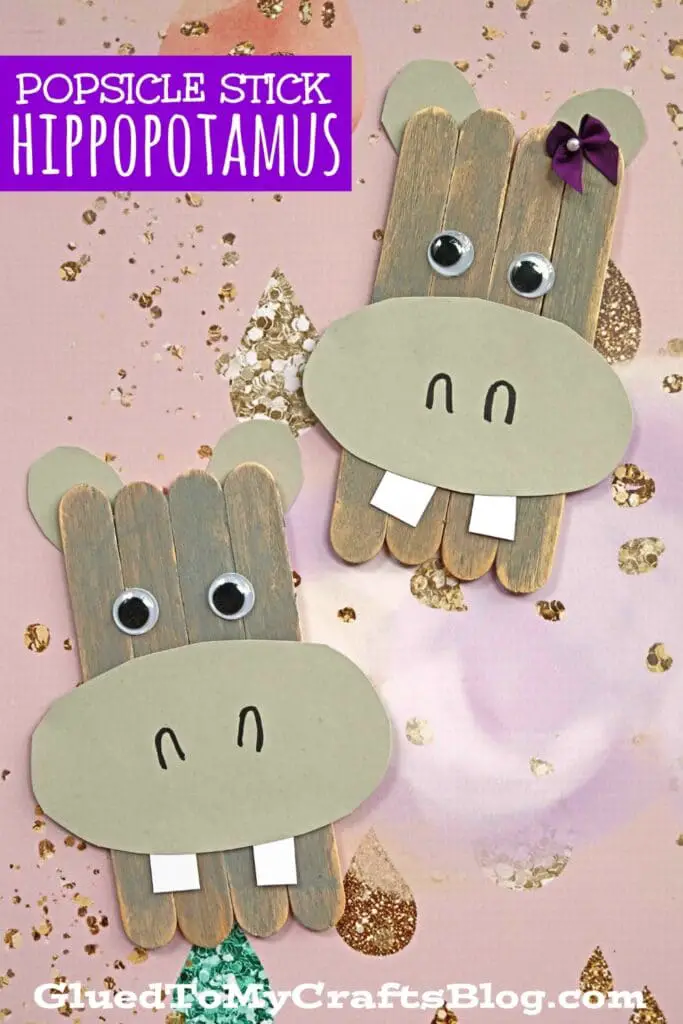
These lovable hippos are simple and easy to make. Try to use modeling and verbal instructions to help children improve their ability to follow instructions and their listening skills.
This craft is a great way to practice children’s cutting and pasting skills. Use this to go with the book “But Not the Hippopotamus” by Sandra Boynton. Children can retell the story using this craft and improve their memory and comprehension skills.
To make the hippopotamus, line up four large craft sticks. Use the hot glue on two mini craft sticks as support. This should look like a fence. Paint this gray and let it dry.
Cut out an oval shape from the gray cardstock to make the muzzle. Ensure that it is wider than the craft sticks. Use the rest of the paper to make the ears. Cut out small oval shapes for these.
Next, cut out two small rectangles from white paper to make the teeth. Attach the muzzle and teeth on the craft stick. Use the black marker to add the nose. Finally, add the googly eyes.
The site suggests using embellishments, such as ribbons, to make the hippos unique.
For this activity, you will need:
- Craft sticks
- Hot glue gun
- Paint
- Paintbrush
- Scissors
- Cardstock
- Marker
- Googly eyes
For more information on this activity, go to GluedToMyCraftsBlog.com.
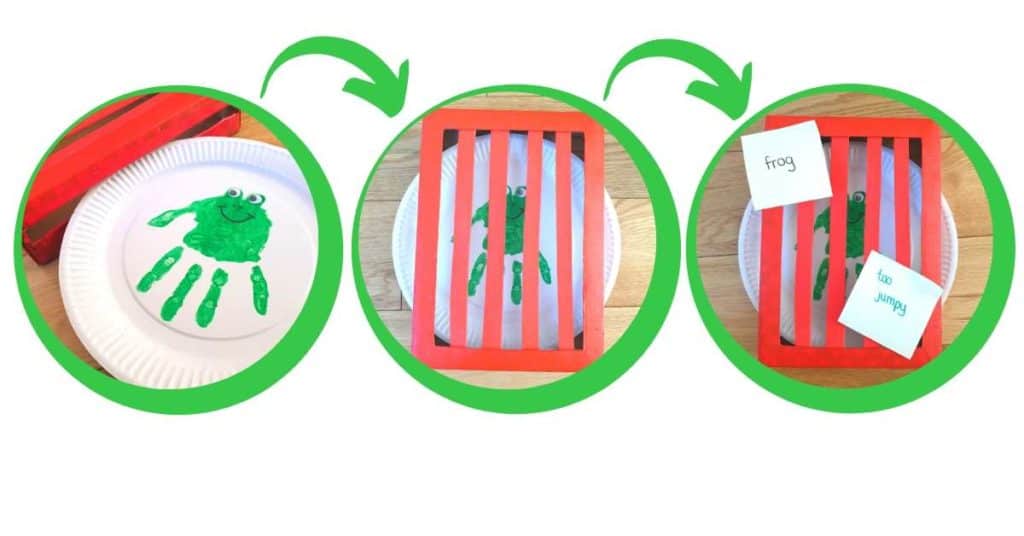
Inspired by the book “Dear Zoo” by Rod Campbell, this craft is a creative way of recreating the story with a personalized touch. The book is about someone writing a letter requesting a pet from the zoo.
Several times, the zoo sent animals, but there seemed to be some issues, so they were returned. The animals arrived in containers, including crates, baskets, and boxes.
With this craft, children will have a sensory experience as they make handprints. Retelling the story will improve children’s comprehension, memory, and oral language skills.
To make the frog, paint the child’s hand green. Carefully press this on a paper plate to create a handprint. Allow the paint to dry. Next, flip the paper plate, so the fingers are on the bottom. This will become the frog’s legs.
Use the black marker to add mouth and nose. Glue the googly eyes and let these dry. Use a similar process to make other animals.
Make the cage bars by cutting strips of craft foam. Glue these together. Ensure that this is slightly wider than the paper plate. Use a cardboard box to hide the paper plate animals while retelling the story.
For this activity, you will need:
- Paper plates
- Paintbrush
- Paints
- Googly eyes
- Glue
- Scissors
- Cardboard box
- Craft foam
For more information on this activity, go to MumsCreativeCupboard.com.
Conclusion
Make learning about zoo animals exciting and interesting for children with these crafts. Knowing the names and characteristics of these animals will allow children to learn to group animals according to categories.
These crafts can help children understand that some wild animals can be kept in a zoo for experts to study and for people to look at and appreciate. Thanks for reading! Come back and check out our other craft articles soon.


